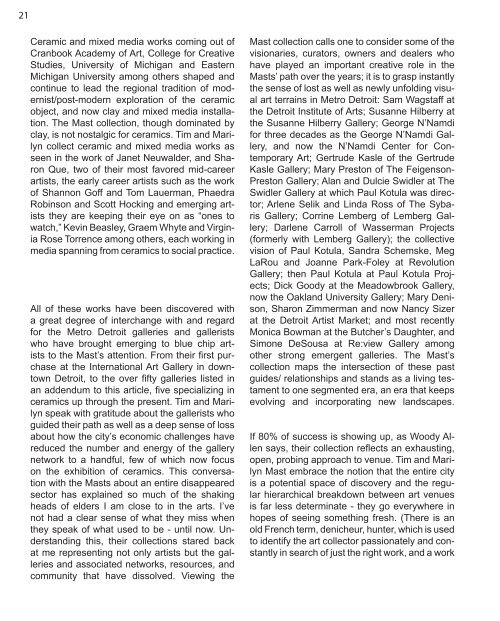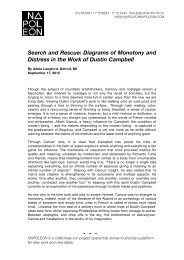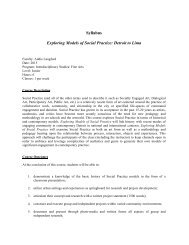COLLECTING TEXTURES: A VISIT WITH TIM AND MARILYN MAST
You also want an ePaper? Increase the reach of your titles
YUMPU automatically turns print PDFs into web optimized ePapers that Google loves.
21<br />
Ceramic and mixed media works coming out of<br />
Cranbook Academy of Art, College for Creative<br />
Studies, University of Michigan and Eastern<br />
Michigan University among others shaped and<br />
continue to lead the regional tradition of modernist/post-modern<br />
exploration of the ceramic<br />
object, and now clay and mixed media installation.<br />
The Mast collection, though dominated by<br />
clay, is not nostalgic for ceramics. Tim and Marilyn<br />
collect ceramic and mixed media works as<br />
seen in the work of Janet Neuwalder, and Sharon<br />
Que, two of their most favored mid-career<br />
artists, the early career artists such as the work<br />
of Shannon Goff and Tom Lauerman, Phaedra<br />
Robinson and Scott Hocking and emerging artists<br />
they are keeping their eye on as “ones to<br />
watch,” Kevin Beasley, Graem Whyte and Virginia<br />
Rose Torrence among others, each working in<br />
media spanning from ceramics to social practice.<br />
All of these works have been discovered with<br />
a great degree of interchange with and regard<br />
for the Metro Detroit galleries and gallerists<br />
who have brought emerging to blue chip artists<br />
to the Mast’s attention. From their first purchase<br />
at the International Art Gallery in downtown<br />
Detroit, to the over fifty galleries listed in<br />
an addendum to this article, five specializing in<br />
ceramics up through the present. Tim and Marilyn<br />
speak with gratitude about the gallerists who<br />
guided their path as well as a deep sense of loss<br />
about how the city’s economic challenges have<br />
reduced the number and energy of the gallery<br />
network to a handful, few of which now focus<br />
on the exhibition of ceramics. This conversation<br />
with the Masts about an entire disappeared<br />
sector has explained so much of the shaking<br />
heads of elders I am close to in the arts. I’ve<br />
not had a clear sense of what they miss when<br />
they speak of what used to be - until now. Understanding<br />
this, their collections stared back<br />
at me representing not only artists but the galleries<br />
and associated networks, resources, and<br />
community that have dissolved. Viewing the<br />
Mast collection calls one to consider some of the<br />
visionaries, curators, owners and dealers who<br />
have played an important creative role in the<br />
Masts’ path over the years; it is to grasp instantly<br />
the sense of lost as well as newly unfolding visual<br />
art terrains in Metro Detroit: Sam Wagstaff at<br />
the Detroit Institute of Arts; Susanne Hilberry at<br />
the Susanne Hilberry Gallery; George N’Namdi<br />
for three decades as the George N’Namdi Gallery,<br />
and now the N’Namdi Center for Contemporary<br />
Art; Gertrude Kasle of the Gertrude<br />
Kasle Gallery; Mary Preston of The Feigenson-<br />
Preston Gallery; Alan and Dulcie Swidler at The<br />
Swidler Gallery at which Paul Kotula was director;<br />
Arlene Selik and Linda Ross of The Sybaris<br />
Gallery; Corrine Lemberg of Lemberg Gallery;<br />
Darlene Carroll of Wasserman Projects<br />
(formerly with Lemberg Gallery); the collective<br />
vision of Paul Kotula, Sandra Schemske, Meg<br />
LaRou and Joanne Park-Foley at Revolution<br />
Gallery; then Paul Kotula at Paul Kotula Projects;<br />
Dick Goody at the Meadowbrook Gallery,<br />
now the Oakland University Gallery; Mary Denison,<br />
Sharon Zimmerman and now Nancy Sizer<br />
at the Detroit Artist Market; and most recently<br />
Monica Bowman at the Butcher’s Daughter, and<br />
Simone DeSousa at Re:view Gallery among<br />
other strong emergent galleries. The Mast’s<br />
collection maps the intersection of these past<br />
guides/ relationships and stands as a living testament<br />
to one segmented era, an era that keeps<br />
evolving and incorporating new landscapes.<br />
If 80% of success is showing up, as Woody Allen<br />
says, their collection reflects an exhausting,<br />
open, probing approach to venue. Tim and Marilyn<br />
Mast embrace the notion that the entire city<br />
is a potential space of discovery and the regular<br />
hierarchical breakdown between art venues<br />
is far less determinate - they go everywhere in<br />
hopes of seeing something fresh. (There is an<br />
old French term, denicheur, hunter, which is used<br />
to identify the art collector passionately and constantly<br />
in search of just the right work, and a work








